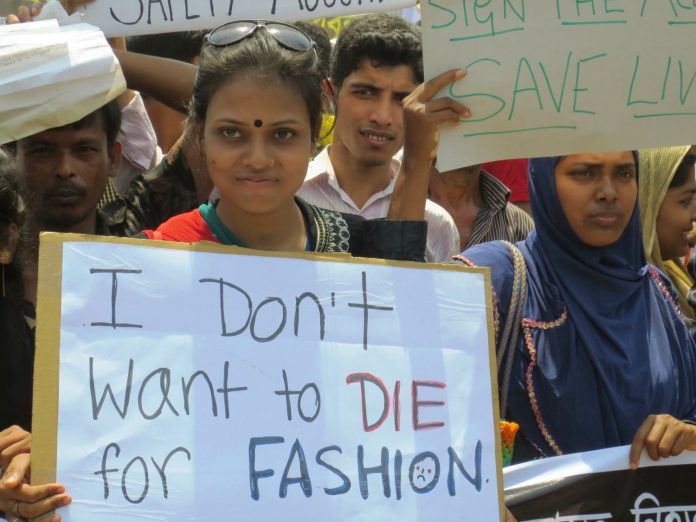Pete Mason and Akhter Khan, Newham and East London Socialist Party
Another female striking worker has been killed by police in Bangladesh as garment workers fight for higher pay, in what has become the biggest industrial battle for a decade, hitting major industrial areas across the country.
Attempts by the bosses to reopen factories, in this two-week-long strike, resulted in mass protests of tens of thousands to try to prevent them. The workers blocked roads and stopped vehicles. Police used tear gas and rubber bullets to try to disperse them, and the protesters threw stones.
Three have died as workers fight a desperate struggle against starvation wages. The minimum wage has not risen for five years. Workers are demanding a tripling of their pay.
When the Bangladesh Garment Manufacturers and Exporters Association (BGMEA) offered only a pitiful 25% rise at the end of October, the workers exploded onto the streets in protest.
Bangladesh capitalism earns $55 billion in annual exports from the super-exploitation of some four million workers, mostly women, in 3,500 garment factories across the country, who live on $75 a month, a little over $2 a day.
The proposed rise would take them to $90. They are demanding $208, and this insult of an offer caused outrage.
On 7 November, after two weeks of protests and strikes, the Bangladesh government offered to increase the minimum wage to $113, a 56% increase, but percentages are meaningless when wages are so small. Rising inflation, now 9.5%, has eaten away at what little their wages buy.
A significant number of members of the ruling party in parliament are also garment business owners, exerting a substantial influence on the government. Politics in Bangladesh is widely perceived by workers as merely an instrument to oppress the working class and exploit labour in Bangladesh’s sweatshops, all to maximise profit.
The hugely valuable products of the workers’ labour accounts for around 85% of Bangladesh’s exports. Many of the world’s top names in fashion, including Levi’s, Zara and H&M, make their money from this exploitation.
The workers’ union president Kalpona Akter, of the Bangladesh Garment and Industrial Workers Federation, told the AFP news agency: “Many workers are half-starving. The brands and retailers only care about smooth shipments and profit. But they don’t care about the wellbeing of the workers at the bottom of the supply chain.”
She added that the main responsibility however lies with the Bangladeshi “factory owners and government.”
The capitalists must be made to pay a decent wage, at least the $208 demanded, together with decent working hours of no more than eight hours a day, five days a week, without loss of pay.
According to the Dhaka Tribune, garment worker Rasel Howlader, 26, died after Gazipur Industrial Police personnel allegedly shot him at close range, and on 8 November, Anjuara Khatun, 28, a sewing machine operator of Islam Garments in Gazipur, died of gunshot injuries after police opened fire on protesters.
In Gazipur about 6,000 workers walked out of their plants and staged protests. Most of the factories remain closed. Elsewhere workers sat on the production floor, suspending work.
Workers in the industrial sector of the capital city Dhaka blocked roads. A sit-down strike hit around ten open factories after clocking in in the same area.
Showing how seriously the capitalist class take the situation, the Dhaka Tribune reported a statement issued by the student leaders who played a major role in the people’s uprising in 1990 that led to the fall of the dictator, President Ershad.
Akhter Khan, one of the signatories and a member of the Socialist Party in England and Wales, told the Socialist:
“Our statement condemned the use of state force against the workers’ just democratic movement, expressing outrage at the unfortunate deaths of some workers during the protests.
“We demanded an immediate end of repression and urged the government to re-evaluate.
“We warned that unless the workers’ wage demands were met, potentially the entire four million garment workers could strike and bring the industry to a standstill.”
This movement takes place while the capitalist opposition parties are calling for repeated two-day hartals (general strikes) and blockades across the country, in an attempt to close all businesses and force the government to concede to an interim caretaker government to conduct fair elections, which are due early next year. A huge number of opposition leaders, supporters and activists have been arrested.
These parties do not support the workers, but the government is under siege. This political movement, and the garment workers’ movement developing simultaneously, is putting significant pressure on the ruling party. The garment workers must continue to expand and consolidate the strike and can win a significant victory.








